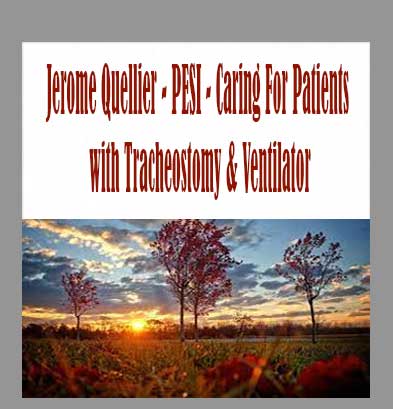Description
Jerome Quellier – PESI – Caring For Patients with Tracheostomy & Ventilator Dependency: A Practitioner’s Guide to Managing Communication and Swallowing download, Jerome Quellier – PESI – Caring For Patients with Tracheostomy & Ventilator Dependency: A Practitioner’s Guide to Managing Communication and Swallowing review, Jerome Quellier – PESI – Caring For Patients with Tracheostomy & Ventilator Dependency: A Practitioner’s Guide to Managing Communication and Swallowing free
Jerome Quellier – PESI – Caring For Patients with Tracheostomy & Ventilator Dependency: A Practitioner’s Guide to Managing Communication and Swallowing
Develop a Comprehensive Management Plan for Adults Living with Acute & Long–Term Tracheostomy
As medical technology and intervention evolves, more patients are faced with temporary and long–term tracheostomy/ventilation as a part of their recovery. The very presence of a tracheostomy tube may elicit visceral reaction to secretion management and dehumanize the patient who is unable to exercise their decision making capacity, orally communicate their needs, and interact socially with staff or family.
Practitioners in acute hospitals, transitional rehabilitation units, skilled long–term settings, and homecare arenas are challenged to not only understand the basic functionality of a tracheostomy tube, but complete daily cares, assist their patients with swallowing and oral communication, and even train non-medical care providers. Management of the tracheostomized patient is often assumed to be complex. This misconception may become a barrier for placement in an environment most conducive to overall rehabilitation; to foster social closeness with staff, friends and family; and ultimately result in prolonging the weaning process.
This recording will outline and compare the basic components of a tracheostomy tube, decision making surrounding the most appropriate type of tube to use for various populations, and the risks/benefits of placement. Through review of daily cares, the assessment and placement of a speaking valve, and dysphagia characteristics for this population, you will build the skills and confidence necessary to develop a comprehensive management plan. Finish this recording with a solid foundation of general knowledge, critical thinking algorithms, and an understanding of the roles and responsibilities of their specialty when faced with tracheostomized patients.
Speaker
Jerome Quellier, MS, CCC-SLP
Jerome Quellier, MS, CCC-SLP, is a specialist in tracheostomy/vent management and traumatic brain injury at a 500+ bed level 1 trauma hospital in Saint Paul, MN. He has accumulated 27+ years of acute, residential, and outpatient rehabilitation experience. During his tenure at the hospital, he has focused on neuro-based diagnostics and intervention for cognitive-linguistic deficits, dysphagia, head and neck cancer management, and patient advocacy. Mr. Quellier has completed advanced training in brain dissection at Marquette University, is a member of a neurosurgery team focused on preserving linguistic & speech function during “wake” craniotomies, and has shared his expertise with interdisciplinary audiences around the country for over a decade.
Speaker Disclosures:
Financial: Jerome Quellier has an employment relationship with Regions Hospital. He receives a speaking honorarium and recording royalties from PESI, Inc. He has no relevant financial relationships with ineligible organizations.
Non-financial: Jerome Quellier is a member of the American Speech-Language and Hearing Association.
Objectives
- Review the components to various tracheostomy tubes available and their functions
- Discuss the decision making process for placement of a tracheostomy tube and the advantages/disadvantages to short- and long-term placement
- Review basic daily nursing cares necessary for maintaining a tracheostomy
- Explain the assessment, safety precautions, and utilization of speaking valves
- Discuss assessment and treatment of swallowing and the application of a speaking valve to minimize aspiration risks and maximize oral communication including bedside screening vs. formal assessment
- Develop a plan of care and establish professional responsibilities across a multidisciplinary team to manage safe swallowing and maintain verbal communication
Outline
ANATOMY AND PHYSIOLOGY OF TRACHEOSTOMY
- Definition of terminology used
- Surgical vs. Percutaneous Tracheostomy
CLINICAL FEATURES OF A TRACHEOSTOMY TUBE INTUBATION AND TRACHEOSTOMY – BENEFITS AND RISKS
- Endotracheal tube advantages/disadvantages
- Tracheostomy tube advantages/disadvantages
SIZING TRACHEOSTOMY TUBES
MANUFACTURERS OF TRACHEOSTOMY TUBES
SPECIAL CONSIDERATIONS OF MANAGING A TRACHEOSTOMY TUBE
- Cuff pressures
- Essential daily cares
- Necessary supplies
- Cannula cleaning/exchanging
- Maintaining stoma and skin integrity
- Minimal Leak technique vs. minimal occlusive volume
SPEAKING VALVES
- Anatomy & physiology of common speaking tubes
- Population and timing
- Warning/Precautions
- Assessment and placement guidelines
- Trouble shooting during valve assessment/use
- Ventilator modifications for safety and success
- Inline speaking valves
- Decision making for the respiratory therapists
- Tidal volumes
- Peak inspiratory pressures
- Minimal vent parameters to facilitate successful application
FENESTRATED TRACHEOSTOMY TUBES
DYSPHAGIA AND THE TRACHEOTOMIZED PATIENT
- Post extubation consideration
- Effect of tracheostomy on swallowing
- Effect of cervical bracing on tracheotomized patient
- Assessment of swallowingBlue Dye vs. Fees vs. MBSS
- Impact of speaking valve upon swallowing
MULTIDISCIPLINARY CARE OF A PATIENT WITH TRACHEOSTOMY
- Role of SLP, nurse, and respiratory therapist
- Review a sample of policy/procedure
Target Audience
- Speech-Language Pathologists
- Speech-Language Pathology Assistants
- Occupational Therapists
- Certified Occupational Therapy Assistants
- Nurse Managers
- Nurses
- Respiratory Therapists
- Rehab Directors
- Licensed Practical Nurses
Frequently Asked Questions:
- Innovative Business Model:
- Embrace the reality of a genuine business! Our approach involves forming a group buy, where we collectively share the costs among members. Using these funds, we purchase sought-after courses from sale pages and make them accessible to individuals facing financial constraints. Despite potential reservations from the authors, our customers appreciate the affordability and accessibility we provide.
- The Legal Landscape: Yes and No:
- The legality of our operations falls into a gray area. While we lack explicit approval from the course authors for resale, there’s a technicality at play. When procuring the course, the author didn’t specify any restrictions on resale. This legal nuance presents both an opportunity for us and a boon for those seeking budget-friendly access.
- Quality Assurance: Unveiling the Real Deal:
- Delving into the heart of the matter – quality. Acquiring the course directly from the sale page ensures that all documents and materials are identical to those obtained through conventional means. However, our differentiator lies in going beyond personal study; we take an extra step by reselling. It’s important to note that we are not the official course providers, meaning certain premium services aren’t included in our package:
- No coaching calls or scheduled sessions with the author.
- No access to the author’s private Facebook group or web portal.
- No entry to the author’s exclusive membership forum.
- No direct email support from the author or their team.
We operate independently, aiming to bridge the affordability gap without the additional services offered by official course channels. Your understanding of our unique approach is greatly appreciated.
- Delving into the heart of the matter – quality. Acquiring the course directly from the sale page ensures that all documents and materials are identical to those obtained through conventional means. However, our differentiator lies in going beyond personal study; we take an extra step by reselling. It’s important to note that we are not the official course providers, meaning certain premium services aren’t included in our package:
Refund is acceptable:
- Firstly, item is not as explained
- Secondly, Item do not work the way it should.
- Thirdly, and most importantly, support extension can not be used.
Thank you for choosing us! We’re so happy that you feel comfortable enough with us to forward your business here.







Reviews
There are no reviews yet.